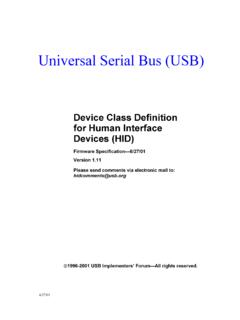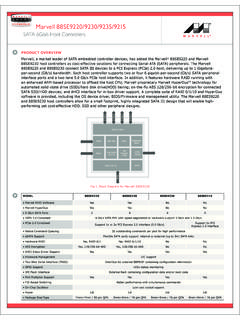Transcription of Introduction To Model-Based System ... - incose.org
1 1 Introduction To Model-Based System Engineering (MBSE) and SysML Presented at the Delaware Valley INCOSE Chapter Meeting July 30, 2015 Laura E. Hart Lockheed Martin, IS&GS 610-354-6529 Copyright 2015 Lockheed Martin Corporation 2 Topics MBE/MBSE Terminology and Overview SysML Overview Object Oriented SE Methodology (OOSEM) Modeling Tools and the Environment 3 Terminology Model: A simplified version of a concept, phenomenon, relationship, structure or System A graphical, mathematical or physical representation An abstraction of reality by eliminating unnecessary components The objectives of a model include; to facilitate understanding to aid in decision making, examine 'what if' scenarios to explain, control, and predict events Model-Based Engineering (MBE): An approach to engineering that uses models as an integral part of the technical baseline that includes the requirements, analysis, design, implementation, and verification of a capability, System , and/or product throughout the acquisition life cycle.
2 Final Report, Model-Based Engineering Subcommittee, NDIA, Feb. 2011 4 Terminology MBSE: Model Based Systems Engineering Those aspects of MBE specifically associated with SE includes behavioral analysis, System architecture, requirement traceability, performance analysis, simulation, test, etc. Model-Based systems engineering (MBSE) is the formalized application of modeling to support System requirements, design, analysis, verification and validation activities beginning in the conceptual design phase and continuing throughout development and later life cycle phases. INCOSE SE Vision 2020 (INCOSE-TP-2004-004-02, Sep 2007) 5 MBSE Focus Formalizes the practice of systems development through the use of models Broad in scope Includes multiple modeling domains across life cycle from SOS to component Results in quality/productivity improvements & lower risk Rigor and precision Communications among development team and customer Management of complexity Life Cycle Support Vertical Integration MBSE Digital models have been common in engineering since the late 1960s but today s focus on Model-Based Engineering goes beyond the use of disparate models Model-Based Engineering moves the record of authority from documents to digital models including M-CAD, E-CAD, SysML and UML managed in a data rich environment Shifting to Model-Based enables engineering teams to more readily understand design change impacts, communicate design intent and analyze a System design before it is built Model-Based Engineering: What, Why and How?
3 6 Document-Centric Model-Centric Model-Based Systems Engineering provides a mechanisms for driving more systems engineering depth without increasing costs Data-centric specifications enable automation and optimization, allowing SEs to focus on value added tasks and ensure a balanced approach is taken Unprecedented levels of systems understanding can be achieved through integrated analytics, tied to a model-centric technical baseline. Model-Based Engineering: What, Why and How? 7 Why Model??? 8 Detailed Design Implementation Unit Test Detect Defects Earlier Operational Tests System Verification and Validation Integration Test and Verification Operational Analysis Requirements Analysis Design, Build, and Test Components System and Architecture Design $$$$ $$$ $$ $ Affordability = Detect Defects Early The key to a successful Model-Based approach is scoping the problem! What do you want to get out of your models? What fidelity do you need to accomplish those goals?
4 What are the success criteria for the effort? Scoping and managing a modeling effort is both an art and a science Driving change in an organization takes time and continuous investment Model-Based Engineering: What, Why and How? 9 10 Model Based Environment Characteristics Set of interconnected Models Models are an abstraction of Reality Structure, Behavior and Requirements Standard Language Graphical Notation, Syntax, Semantics Visual focus Static and Dynamic Shared System Information Base 11 SE Practices for Describing Systems AirplaneATCP ilotRequest to proceedAuthorizePower-upInitiate power-upDirect taxiwayReport StatusExecuted cmdsInitiate Taxi11 Specifications Interface requirements System design Analysis & Trade-off Test plans Moving from Document centric to Model centric Past Future Methodology (OOSEM) Tools Language (SysML) Tools (Rhapsody) Document Centric Model Centric Copyright 2006 by Object Management Group.
5 12 System Modeling Integrated System Model Must Address Multiple Aspects of a System Start Shift Accelerate Brake Engine Transaxle Control Input Power Equations Vehicle Dynamics Functional / Behavioral Model Structural / Component Model Performance Model Mass Properties Model Structural Model Safety Model Other Engineering Analysis Models System Model Transmission from OMG Auto Cost Model Requirement Model Copyright 2006 by Object Management Group. 13 Modeling Helps Produce Improved System and software Specification Visualization Architecture Construction Simulation and Test Documentation Validation and Verification Improved communications Enhanced knowledge capture and transfer Training Support Improved design quality Decreased ambiguity Increased precision Supports evaluation of Consistency, Correctness & Completeness Supports evaluation of trade space Increased ability to manage System Complexity Model can be viewed from multiple perspectives Supports concurrent and distributive teams Traceability Supports impact/change analysis Complex development lifecycles Incremental, iterative, parallel 14 Stakeholders Involved in System Acquisition Testers Developers/ Integrators Vendors Regulators Customers Project Managers Modeling Needed to Improve Communications across all Stakeholders from OMG Copyright 2006 by Object Management Group.
6 15 Information Base Characteristics Document Based MBSE Based Information - Mostly Text - Add Hoc Diagrams - Loosely coupled, repeated in multiple documents - Visual and Textual - Constructs Defined once and re-used - Shared across Domains - Consistent notation in diagrams - Defined relationships Information Views - By Document - Provides Viewpoints - Filters By Domain, Problem Space, etc. Measuring Change Impact - Spans across Multiple Documents - Often Text Reqts. Are isolated from Structure and Behavior - Relationships define traceability paths - Natural part of the modeling process - Programmatically Automated Measuring Integrity - Completeness, Quality & Accuracy - By manual inspection - Programmatically Automated - Animation of Spec 16 Software Models Mechanical & Electrical Models Q Q SET CLR S R Verification Models Performance, RMA, SWaP, Cost, etc. G ( s ) U ( s ) Analytical Models The MBSE Integration Across Domains MBSE Manufacturing Program Management Product Support System Architectural Model Test Plan Analysis Spec 17 System Architecture Models vs.
7 Analytical Models System Architecture Model Emphasize how pieces fit together into a consistent whole Repository-based to support capture of inter-relationships Used to capture functions, behavior structure, components, objects info flow, interfaces, ports Interactions, scenarios A vehicle to hang & integrate analysis products Analytic Model Emphasize specific aspects of performance, consistent with the Architecture Model Mathematically-based to computation or simulation Reduce risks thru analysis, validation and optimization of: MoM, MOE, MOP, KPP, TPM timing, probability of hit/survival reliability/availability, MTBF cost, total cost of ownership A vehicle to solve some problem or verify a solution Consistency: Faithful to all known and relevant aspects of the System at the current time 18 System Model Requirements What are the stakeholder goals, purposes, and success conditions for the System Specification of black box behavior and characteristics Behavior What the System has to do to meet the requirements Transformations of inputs to outputs (functional/activity models) State/Mode-based behavioral differences (state models) Responses to incoming requests for services (message models)
8 Structure The parts that exhibit the behavior The component hierarchy, elements, and stores Properties The performance, physical characteristics and governing rules that constrain the structure and behavior Interconnections The way the structural elements arrange and communicate to achieve the required behavior under the given constraints System Model A structured representation that focuses on the overall System requirements, behavior, structure, properties, & interconnections 120-18 19 Complete Subsystem Specs Analyze System Services Analyze System Level Requirements Analyze Subsystem Collaboration to Satisfy the System Services Derive and Allocate Requirements to Subsystem Identify the Subsystem Continue? No Incorporate Additional Analysis as Needed System Decomposition Process using SysML SatCommsForward Message from Regional CommandForward Message to Regional CmdForward Message to Regional CmdWeaponFire WeaponCorrect CourseWeapon SystemReceive OrderEvaluate EngagementStart EnagementTerminate EngagementMonitor WeaponSend Guidance Command[Correction Needed]Send Status Change[Status Change]Weapon Intercept?
9 [No]SatCommsForward Message from Regional CommandForward Message to Regional CmdForward Message to Regional CmdWeaponFire WeaponCorrect CourseWeapon SystemReceive OrderEvaluate EngagementStart EnagementTerminate EngagementMonitor WeaponSend Guidance Command[Correction Needed]Send Status Change[Status Change]Weapon Intercept?[No]SatCommsForward Message from Regional CommandForward Message to Regional CmdForward Message to Regional CmdWeaponFire WeaponCorrect CourseWeapon SystemReceive OrderEvaluate EngagementStart EnagementTerminate EngagementMonitor WeaponSend Guidance Command[Correction Needed]Send Status Change[Status Change]Weapon Intercept?[No]SatCommsForward Message from Regional CommandForward Message to Regional CmdForward Message to Regional CmdWeaponFire WeaponCorrect CourseWeapon SystemReceive OrderEvaluate EngagementStart EnagementTerminate EngagementMonitor WeaponSend Guidance Command[Correction Needed]Send Status Change[Status Change]Weapon Intercept?
10 [No][Correction Needed][Status Change][No]The Subsystem shall .. Derived Requirements SatCommsForward Message from Regional CommandForward Message to Regional CmdForward Message to Regional CmdWeaponFire WeaponCorrect CourseWeapon SystemReceive OrderEvaluate EngagementStart EnagementTerminate EngagementMonitor WeaponSend Guidance Command[Correction Needed]Send Status Change[Status Change]Weapon Intercept?[No]SatCommsForward Message from Regional CommandForward Message to Regional CmdForward Message to Regional CmdWeaponFire WeaponCorrect CourseWeapon SystemReceive OrderEvaluate EngagementStart EnagementTerminate EngagementMonitor WeaponSend Guidance Command[Correction Needed]Send Status Change[Status Change]Weapon Intercept?[No]SatCommsForward Message from Regional CommandForward Message to Regional CmdForward Message to Regional CmdWeaponFire WeaponCorrect CourseWeapon SystemReceive OrderEvaluate EngagementStart EnagementTerminate EngagementMonitor WeaponSend Guidance Command[Correction Needed]Send Status Change[Status Change]Weapon Intercept?


